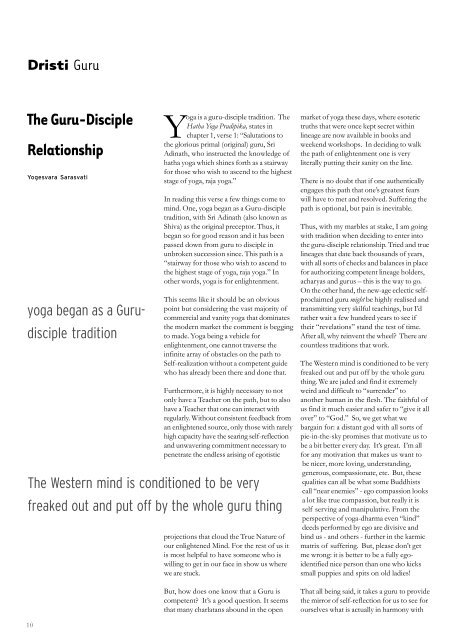Create successful ePaper yourself
Turn your PDF publications into a flip-book with our unique Google optimized e-Paper software.
Dristi Guru<br />
The Guru-Disciple<br />
Relationship<br />
Yogesvara Sarasvati<br />
yoga began as a Gurudisciple<br />
tradition<br />
Yoga is a guru-disciple tradition. The<br />
Hatha Yoga Pradipika, states in<br />
chapter 1, verse 1: “Salutations to<br />
the glorious primal (original) guru, Sri<br />
Adinath, who instructed the knowledge of<br />
hatha yoga which shines forth as a stairway<br />
for those who wish to ascend to the highest<br />
stage of yoga, raja yoga.”<br />
In reading this verse a few things come to<br />
mind. One, yoga began as a Guru-disciple<br />
tradition, with Sri Adinath (also known as<br />
Shiva) as the original preceptor. Thus, it<br />
began so for good reason and it has been<br />
passed down from guru to disciple in<br />
unbroken succession since. This path is a<br />
“stairway for those who wish to ascend to<br />
the highest stage of yoga, raja yoga.” In<br />
other words, yoga is for enlightenment.<br />
This seems like it should be an obvious<br />
point but considering the vast majority of<br />
commercial and vanity yoga that dominates<br />
the modern market the comment is begging<br />
to made. Yoga being a vehicle for<br />
enlightenment, one cannot traverse the<br />
infinite array of obstacles on the path to<br />
Self-realization without a competent guide<br />
who has already been there and done that.<br />
Furthermore, it is highly necessary to not<br />
only have a Teacher on the path, but to also<br />
have a Teacher that one can interact with<br />
regularly. Without consistent feedback from<br />
an enlightened source, only those with rarely<br />
high capacity have the searing self-reflection<br />
and unwavering commitment necessary to<br />
penetrate the endless arising of egotistic<br />
The Western mind is conditioned to be very<br />
freaked out and put off by the whole guru thing<br />
projections that cloud the True Nature of<br />
our enlightened Mind. For the rest of us it<br />
is most helpful to have someone who is<br />
willing to get in our face in show us where<br />
we are stuck.<br />
But, how does one know that a Guru is<br />
competent? It’s a good question. It seems<br />
that many charlatans abound in the open<br />
market of yoga these days, where esoteric<br />
truths that were once kept secret within<br />
lineage are now available in books and<br />
weekend workshops. In deciding to walk<br />
the path of enlightenment one is very<br />
literally putting their sanity on the line.<br />
There is no doubt that if one authentically<br />
engages this path that one’s greatest fears<br />
will have to met and resolved. Suffering the<br />
path is optional, but pain is inevitable.<br />
Thus, with my marbles at stake, I am going<br />
with tradition when deciding to enter into<br />
the guru-disciple relationship. Tried and true<br />
lineages that date back thousands of years,<br />
with all sorts of checks and balances in place<br />
for authorizing competent lineage holders,<br />
acharyas and gurus – this is the way to go.<br />
On the other hand, the new-age eclectic selfproclaimed<br />
guru might be highly realised and<br />
transmitting very skilful teachings, but I’d<br />
rather wait a few hundred years to see if<br />
their “revelations” stand the test of time.<br />
After all, why reinvent the wheel? There are<br />
countless traditions that work.<br />
The Western mind is conditioned to be very<br />
freaked out and put off by the whole guru<br />
thing. We are jaded and find it extremely<br />
weird and difficult to “surrender” to<br />
another human in the flesh. The faithful of<br />
us find it much easier and safer to “give it all<br />
over” to “God.” So, we get what we<br />
bargain for: a distant god with all sorts of<br />
pie-in-the-sky promises that motivate us to<br />
be a bit better every day. It’s great. I’m all<br />
for any motivation that makes us want to<br />
be nicer, more loving, understanding,<br />
generous, compassionate, etc. But, these<br />
qualities can all be what some Buddhists<br />
call “near enemies” - ego compassion looks<br />
a lot like true compassion, but really it is<br />
self serving and manipulative. From the<br />
perspective of yoga-dharma even “kind”<br />
deeds performed by ego are divisive and<br />
bind us - and others - further in the karmic<br />
matrix of suffering. But, please don’t get<br />
me wrong: it is better to be a fully egoidentified<br />
nice person than one who kicks<br />
small puppies and spits on old ladies!<br />
That all being said, it takes a guru to provide<br />
the mirror of self-reflection for us to see for<br />
ourselves what is actually in harmony with<br />
10

















